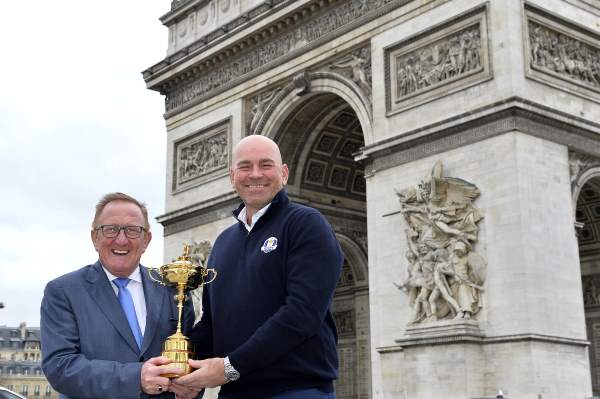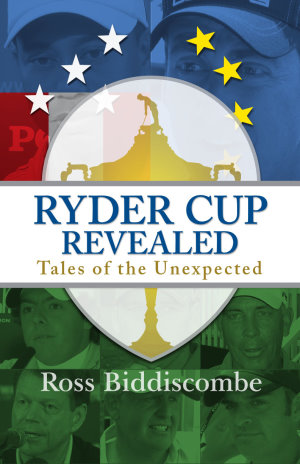Le Golf National will be the venue where one of the most significant men in the recent history of the Ryder Cup takes his final bow. Richard Hills has been the man in charge of the commercial aspects of all the Ryder Cup matches for almost a quarter of a century.

As Ryder Cup Director, he began his role in 1995 at a crucial time for the biennial contest, just a few years after the European Tour became managing partner of the Ryder Cup matches in Europe. The Tour took over responsibility for staging the matches from the PGA whose bosses recognised that they needed much more help to develop the sport’s most important team competition. Hills was the man charged with overseeing those developments.
But this was no easy task – the European team had made a huge performance breakthrough in the mid-1980s under Tony Jacklin’s captaincy, but then they hit a rougher patch, only managing a tie in 1989 before losing in the US in 1991 and then again two years later at The Belfry. Suddenly the line of sponsors and commercial supporters wanting to be aligned with an all-conquering Euros were getting a little nervous.
In fact, commercial support for the European matches had been sketchy at best for a long time before the Jacklin years or the appointment of Hills. Early match patronage by the likes of Samuel Ryder himself and others was replaced during the 1960s through to the 1980s by sponsors like Senior Service (a tobacco company), Sun Alliance (an insurance broker) and most notably Johnnie Walker (a whisky brand). But with only one match for commercial partners to benefit from every four years, selling sponsorship was easy. Only a decade before Hills began his Ryder Cup job, one of the best offers on the table for the European team consisted of £80,000 worth of cigarette coupons or £100,000 in Green Shield stamps.
Hills’ predecessor Colin Snape of the PGA had done a great job under difficult circumstances and, by 1993, the match at The Belfry was known as ‘The Ryder Cup by Johnnie Walker’. But there were issues with this sponsorship of the European team when it played in America – advertising a whisky at a sporting event was not allowed, plus Johnnie Walker’s distribution in the US hardly warranted a lot of cash, so something had to change.
“One umbrella sponsor was certainly easier to manage and it also guaranteed a certain level sponsorship revenue,” says Hills. “But it was also restrictive on the brand and identity of the Ryder Cup itself, and I think there was an unsaid consensus among us that we had an incredible opportunity to take the event forward that was too big to miss.”
This was the view in the 1990s and, by coincidence, there was plenty of good news for Hills because a commercial blueprint being established for quadrennial sponsorships by arguably the largest sporting brand in the world, the Olympic Games.
So, taking the commercial aspect of the once-every-four-year match as well as its brand to the next level would mean adopting this more sophisticated structure of sponsors and partnerships. The way ahead was to create a top line of official partners supported by official suppliers to the match as well as the European team and then a group of licensees.
“We needed to evolve and did a lot of research on the International Olympic Committee’s sponsorship model was undertaken,” says Hills, “as they had recently moved towards developing ‘family’ of official sponsors. Thankfully, we moved to the Official Partner model which remains in place today and allows us to maximise the commercial potential of The Ryder Cup.”
 Therefore, the family of sponsors for this month’s match totals 31 including four partners – Rolex, Aberdeen Standard Investments, Emirates and BMW – plus 12 match suppliers, three team suppliers and a dozen match licensees.
Therefore, the family of sponsors for this month’s match totals 31 including four partners – Rolex, Aberdeen Standard Investments, Emirates and BMW – plus 12 match suppliers, three team suppliers and a dozen match licensees.
The joy of so many sponsors is that the loss of one is far less significant than it used to be. For example, in 2014 at Gleneagles, the corporate sponsor list totaled five major names: BMW, Rolex, Johnnie Walker, Ernst & Young and Standard Life Investments. This year the number is four, yet overall commercial progress has continued.
“One brand being associated with the Ryder Cup was not the way forward,” Hills said in the book Ryder Cup Revealed. He admired the ‘The Olympic Programme’ (TOP), but also studied the evolution of the multi-sponsor strategy of the Champions League. “We felt these structures were compatible with the way we wanted the Ryder Cup to progress, and it has been the case that this system has worked well.”
In terms of absolute cash into the Ryder Cup’s bank account from sponsorship, the amount was estimated four years ago to be in the range upwards of the $10 million on both sides of the Atlantic, according to Ryder Cup Revealed. But this figure may now be more like $12-15 million and is a large part of the total commercial income of each match which can be guesstimated nowadays at more than $70 million which includes TV rights fees, merchandise and ticket revenue. This is a small fraction of what incomes the Olympic Games or FIFA World Cup generate, but it’s a whole lot more than an offer of a few hundred thousand pounds worth of Green Shield stamps.
Richard Hills has been at the centre of the Ryder Cup’s commercial growth and appreciates the differences from over two decades ago. “The night after Europe, led by Seve Ballesteros, won the 1997 Ryder Cup, eight people sat round a table at Valderrama for dinner and to start planning for the 1999 matches in Brookline,” remembers Hills. “It still astonishes me that was only 21 years ago – eight people representing both sides! To think that there are now hundreds of personnel involved in staging a Ryder Cup, all working on an incredibly intricate and complex plan which takes anything from 5-10 years to execute properly is a great way to illustrate the growth rate.
“Now, we have full-time teams and contractors working years in advance on staging and logistics; commercial partnerships; ticketing; marketing; hospitality; media and communications; charity; corporate responsibility and other facets which make staging the event so challenging and, ultimately, rewarding.”
And the commercial momentum that Hills has put into place means that forward planning for revenues is now about the next decade rather than the next year. This means Hills’ successor, former IMG senior vice president and chairman of golf Guy Kinnings, will enjoy a much happier situation than the one his predecessor inherited in 1995.
Ross Biddiscombe’s acclaimed book Ryder Cup Revealed, which is referred to in this feature, is available at amazon.co.uk via this hotlink: https://tinyurl.com/y9w75whd
Ryder Cup https://www.rydercup.com/

